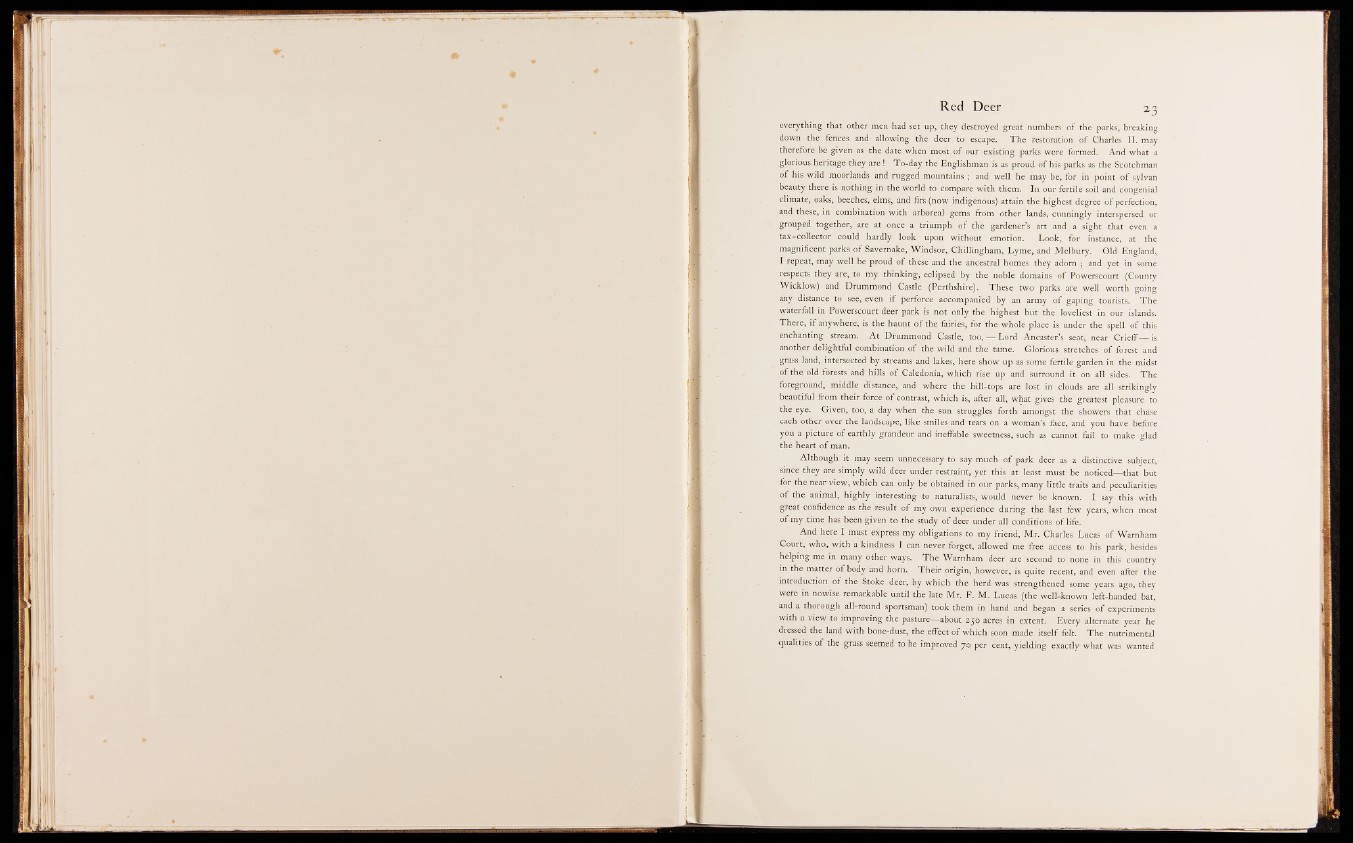
Red Deer ^ 3
everything that other men had set up, they destroyed great numbers o f the parks, breaking
down the fences and allowing the deer to escape. The restoration o f Charles II. may
therefore be given as the date when most o f our existing parks were formed. And what a
glorious heritage they are ! To-day the Englishman is as proud o f his parks as the Scotchman
o f his wild moorlands and rugged mountains ; and well he may be, for in point o f sylvan
beauty there is nothing in the world to compare with them. In our fertile soil and congenial
climate, oaks, beeches, elms, and firs (now indigenous) attain the highest degree o f perfection,
and these, in combination with arboreal gems from other lands, cunningly interspersed or
grouped together, are at once a triumph o f the gardener’s art and a sight that even a
tax-collector could hardly look upon without emotion. Look, for instance, at the
magnificent parks o f Savernake, Windsor, Chillingham, Lyme, and Melbury. Old England,
I repeat, may well be proud o f these and the ancestral homes they adorn ; and yet in some
-respects they are, to my thinking, eclipsed by the noble domains o f Powerscourt (County
Wicklow) and Drummond Castle (Perthshire). These two parks are well worth going
any distance to see, even i f perforce accompanied by an army o f gaping tourists. The
waterfall in Powerscourt deer park is not only the highest but the loveliest in our islands.
There, i f anywhere, is the haunt o f the fairies, for the whole place is under the spell o f this
enchanting stream. A t Drummond Castle, too, — Lord Ancaster’s seatj near Crieff— is
another delightful combination o f the wild and the tame. Glorious stretches o f forest and
grass land, intersected by streams and lakes, here show up as some fertile garden in the midst
o f the old forests and hills o f Caledonia, which rise up and surround it on all sides. The
foreground, middle distance, and where the hill-tops are lost in clouds are all strikingly
beautiful from their force o f contrast, which is, after all, what gives the greatest pleasure to:
the eye. Given, too, a day when the sun struggles forth amongst the showers that chase
each other over the landscape, like smiles and tears on a woman’s face, and you have before
you a picture o f earthly grandeur and ineffable sweetness, such as cannot fail to make glad
the heart o f man.
Although it may seem unnecessary to say much o f park deer as a distinctive subject,
since they are simply wild deer under restraint, yet this at least must be noticed— that but
for the near view, which can only be obtained in our parks, many little traits and peculiarities
o f the animal, highly interesting to naturalists, would never be known. I say this with
great confidence as the result o f my own experience during the last few years, when most
o f my time has been given to the study o f deer under all conditions o f life.
And here I must express my obligations to my friend, Mr. Charles Lucas o f Warnham
Court, who, with a kindness I can never forget, allowed me free access to his park, besides
helping me in many other ways. The Warnham deer are second to none in this country
in the matter o f body and horn. Their origin, however, is quite recent, and even after the
introduction o f the Stoke deer, by which the herd was strengthened s.ome years ago, they
were in nowise remarkable until the late Mr. F. M. Lucas (the well-known left-handed bat,
and a thorough all-round sportsman) took them in hand and began a series o f experiments
with a view to improving the pasture— about 250 acres in extent. Every alternate year he
dressed the land with bone-dust, the effect o f which soon made itself felt. The nutrimental
qualities o f the grass seemed to be improved 70 per cent, yielding exactly what was wanted